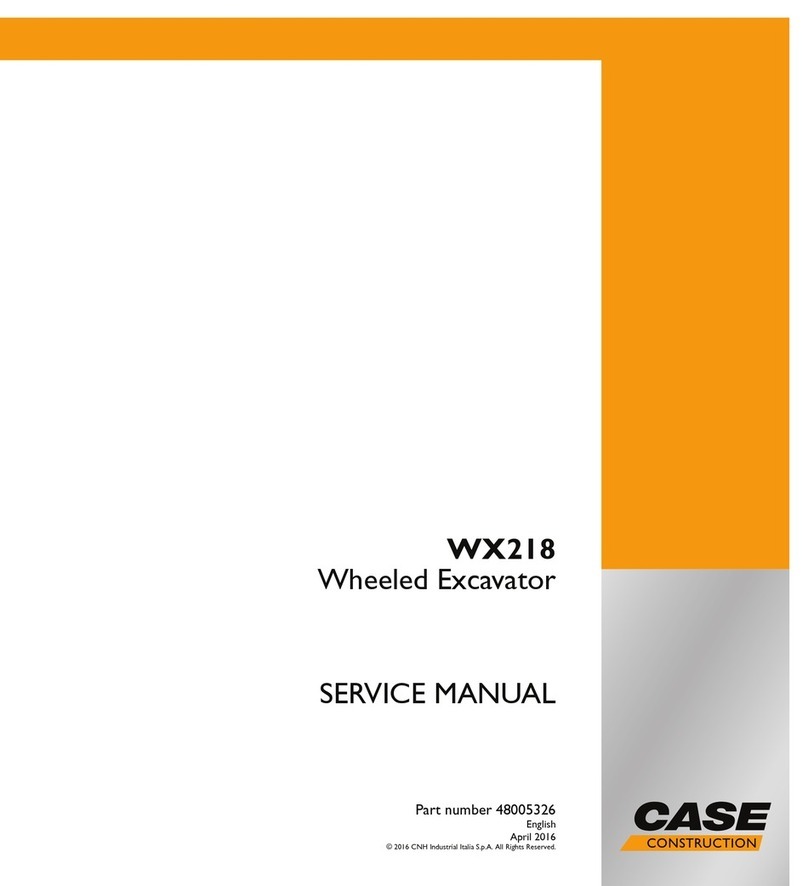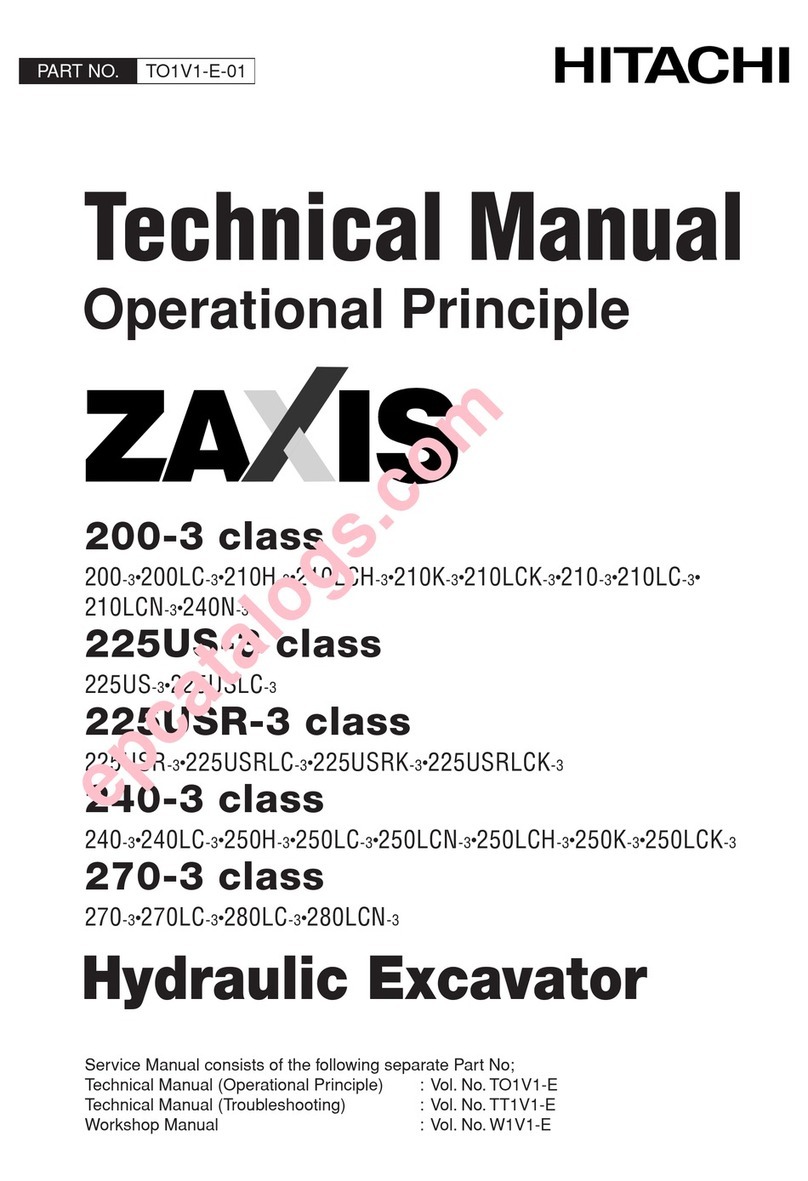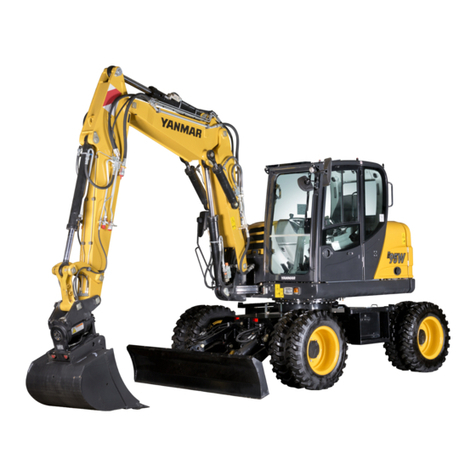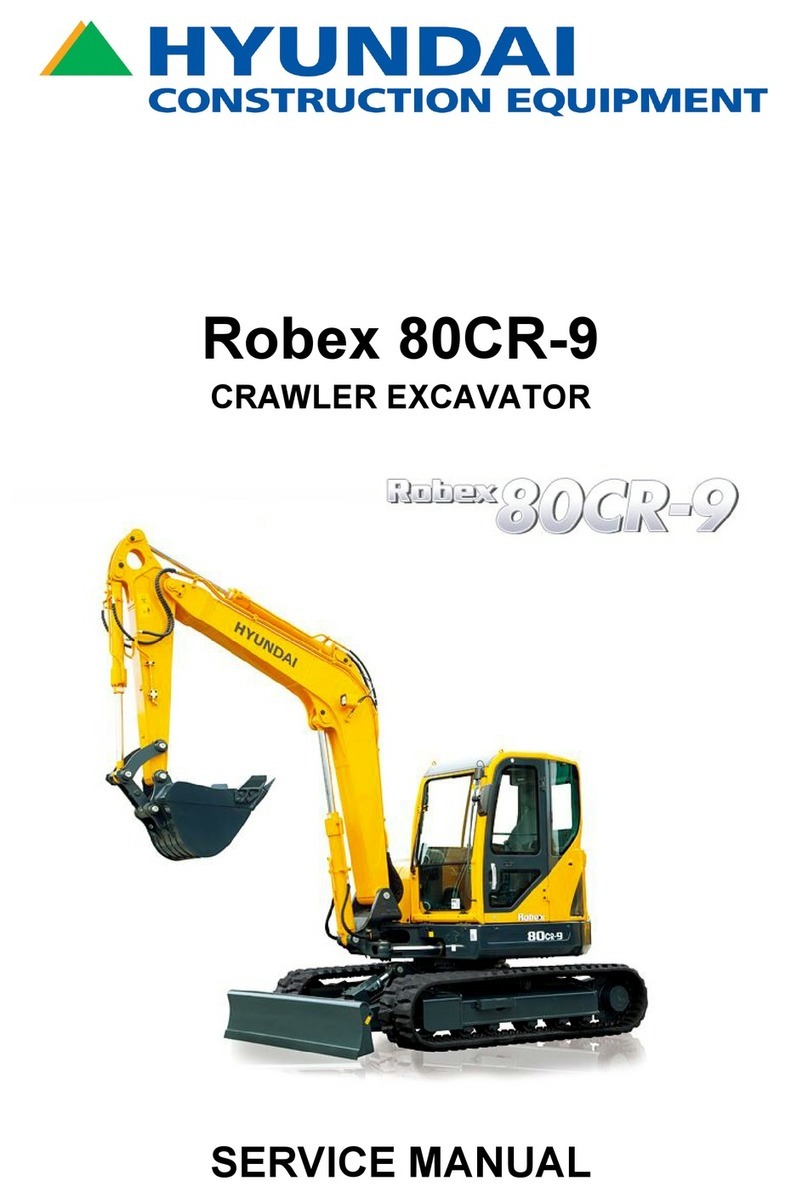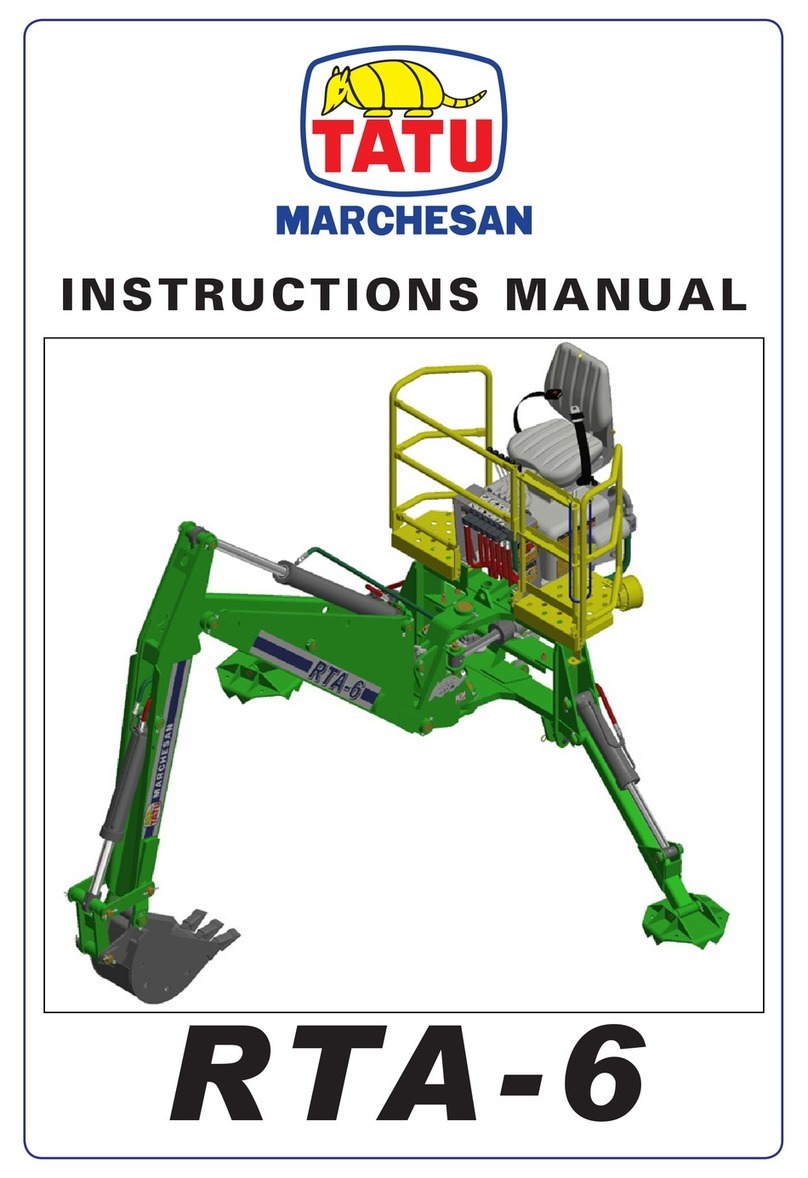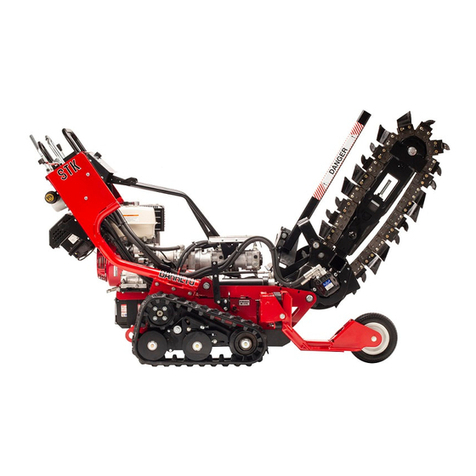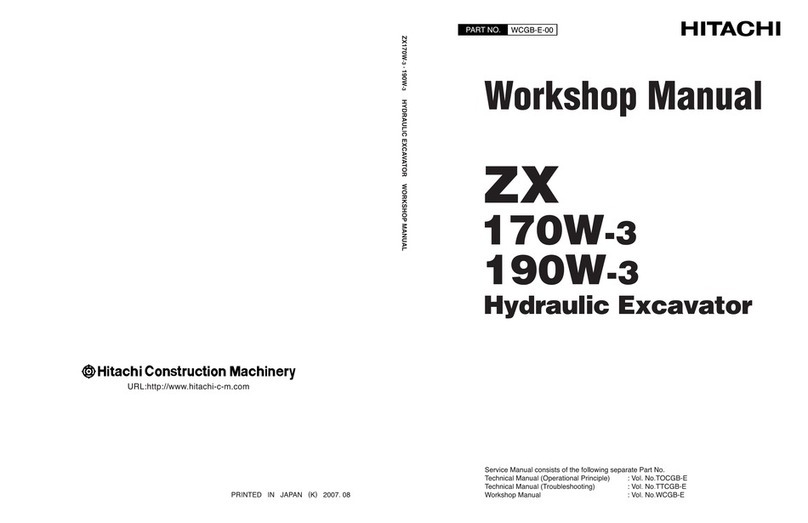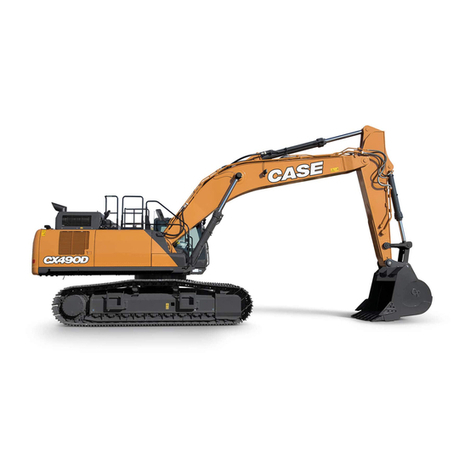Eurotrac HE18 User manual

Eurotrac Construc�on Machinery
Stougjesdijk 153
3271 KB Mijnsheerenland
The Netherlands
Tel: +31 (0) 18 66 12 333
E-mail: info@eurotrac.nl
MINI EXCAVATOR
HE18 · HE18-C
USER MANUAL

CONTENTS
HE18 | Handleiding
GENERAL . . . . . . . . . . . . . . . . . . . . . . . . . . . . . . . . . . . . . . . . . . . . . . . . . . . . . . . . . . . . . . . . . . . . . . . . . . . . 7
1. Foreword ................................................................................................................................... 7
2. EC Declaration of Conformity ..................................................................................................... 8
3. Operating Personnel ................................................................................................................... 9
4. Storage of the operating instructions ......................................................................................... 9
5. Parts ........................................................................................................................................... 9
SAFETY PROVISIONS . . . . . . . . . . . . . . . . . . . . . . . . . . . . . . . . . . . . . . . . . . . . . . . . . . . . . . . . . . . . . . . . . . 10
1. General safety instructions ....................................................................................................... 10
2. Obligation, Liability and Warranty ............................................................................................ 10
3. Authorized Use ......................................................................................................................... 11
4. Unauthorized Use ..................................................................................................................... 11
5. Particular Obligations on the Part of the Operator ................................................................... 11
6. Noise Emissions and Vibrations ................................................................................................ 12
6.1 Noise Emissions.................................................................................................................................. 12
6.2 Vibrations ........................................................................................................................................... 12
7. Safety Symbols on the Excavator .............................................................................................. 13
8. Safety Facilities ........................................................................................................................ 21
8.1 Securing the Control Elements........................................................................................................... 21
8.2 Protective Structure of the Protective Roof and Cab......................................................................... 22
8.3 Emergency Hammer........................................................................................................................... 22
8.4 Locking the superstructure ................................................................................................................ 23
9. Danger: hydraulic system ......................................................................................................... 23
10. Fire Safety ................................................................................................................................ 24
STORAGE, LOADING AND TRANSPORT . . . . . . . . . . . . . . . . . . . . . . . . . . . . . . . . . . . . . . . . . . . . . . . . . . . 25
1. Safety Provisions for Storage .................................................................................................... 25
2. Safety Provisions for Loading and Unloading with a Crane ........................................................ 25
3. Safety Provisions with Transport .............................................................................................. 26
4. Storing ..................................................................................................................................... 26
5. Loading/Unloading the Excavator with a Crane ........................................................................ 27
6. Transport by Flatbed Trailer ..................................................................................................... 28
DESCRIPTION OF THE MACHINE . . . . . . . . . . . . . . . . . . . . . . . . . . . . . . . . . . . . . . . . . . . . . . . . . . . . . . . . . 30
1. Overview of the models ........................................................................................................... 30
2. Dimensions .............................................................................................................................. 31
3. Technical data .......................................................................................................................... 32

CONTENTS
HE18 | Handleiding
4. Identification of the Excavator ................................................................................................. 33
4.1 Serial Number on the Machine .......................................................................................................... 33
4.2 Engine number ................................................................................................................................... 33
5. Basic Equipment ....................................................................................................................... 34
STRUCTURE AND OPERATION. . . . . . . . . . . . . . . . . . . . . . . . . . . . . . . . . . . . . . . . . . . . . . . . . . . . . . . . . . . 35
1. Overview of Parts ..................................................................................................................... 35
2. Driving position ........................................................................................................................ 36
2.1 Left control console............................................................................................................................ 36
2.1.1 Description of the parts of the left control console ............................................................ 36
2.2 Drive Levers and Pedal Mechanism ................................................................................................... 37
2.2.1 Description of the parts of the drive lever and the pedal mechanism ............................... 37
2.3 Right control console.......................................................................................................................... 38
2.3.1 Description of the parts of the right control console .......................................................... 39
2.4 Other Equipment in the Driving Position ........................................................................................... 40
2.4.1 Interior lighting ................................................................................................................... 40
2.4.2 Fuse box .............................................................................................................................. 40
2.4.3 Tool compartment .............................................................................................................. 40
2.4.4 Funnel for diesel .................................................................................................................. 40
2.5 Setting the Width of the Undercarriage............................................................................................. 41
3. Other Equipment on the Machine ............................................................................................ 42
3.1 Vehicle battery ................................................................................................................................... 42
3.2 Battery separation switch .................................................................................................................. 42
3.3 Direct return changeover valve.......................................................................................................... 42
3.4 The fuel tank filler opening and level check....................................................................................... 42
3.5 Exterior mirrors .................................................................................................................................. 43
4. Heating .................................................................................................................................... 43
5. Engine Area .............................................................................................................................. 44
6. Hydraulic System ...................................................................................................................... 45
7. Radiator and Oil Cooler ............................................................................................................ 45
OPERATION . . . . . . . . . . . . . . . . . . . . . . . . . . . . . . . . . . . . . . . . . . . . . . . . . . . . . . . . . . . . . . . . . . . . . . . . . 46
1. Safety Instructions for Use ....................................................................................................... 46
1.1 Safety and children............................................................................................................................. 47
1.2 Assisting the user ............................................................................................................................... 47
1.3 Conduct when working in the area of electrical overhead cables ..................................................... 48
1.4 Conduct when Working in the area of ground cables........................................................................ 48
2. Putting into Service the First Time ............................................................................................ 49
2.1 Breaking in the excavator................................................................................................................... 49
2.2 Special maintenance instructions ...................................................................................................... 49
3. Use of the Excavator ................................................................................................................. 50
3.1 Activities before daily commissioning................................................................................................ 50
3.2 Getting in............................................................................................................................................ 55
3.3 Adjusting the driver’s seat.................................................................................................................. 56

CONTENTS
HE18 | Handleiding
3.4 Adjusting the exterior mirrors............................................................................................................ 57
3.5 Safety instruction before starting the engine .................................................................................... 57
3.5.1 Starting the engine .............................................................................................................. 58
3.6 Switching the engine off..................................................................................................................... 59
3.7 Checking the indications after starting and while operating ............................................................. 60
3.8 Driving the excavator ......................................................................................................................... 65
3.9 Excavation (using the control elements)............................................................................................ 69
3.9.1 Operating instructions for wide and deep buckets ............................................................. 69
3.9.2 Operating the dozer blade .................................................................................................. 70
3.9.3 Overview of the functions of the control levers ................................................................. 70
3.9.4 Operating the boom ............................................................................................................ 71
3.9.5 Operating the arm ............................................................................................................... 71
3.9.6 Operating the bucket .......................................................................................................... 72
3.9.7 Swiveling the superstructure .............................................................................................. 73
3.9.8 Swiveling the boom ............................................................................................................. 73
3.9.9 Operating the extra circuit (option) .................................................................................... 74
3.9.10 Decrease the pressure in the hydraulic system .................................................................. 76
3.10 Putting out of operation..................................................................................................................... 77
3.11 Heating ............................................................................................................................................... 78
3.12 Operating the windshield cleaning system (cab model) .................................................................... 79
3.13 Operating the interior lighting (cab model) ....................................................................................... 80
3.14 Operating the flashing light (accessories) .......................................................................................... 80
3.15 Operating the 12-V power strip ......................................................................................................... 80
3.16 Opening/closing the cab door (cab model)........................................................................................ 81
3.17 Opening/closing the windows (cab model)........................................................................................ 82
3.18 Operating the work lights................................................................................................................... 83
3.19 Using in the winter ............................................................................................................................. 84
3.20 Starting the excavator with a starting aid .......................................................................................... 85
3.21 Filling the windshield washer system................................................................................................. 86
3.22 Filling up the excavator ...................................................................................................................... 86
MAINTENANCE . . . . . . . . . . . . . . . . . . . . . . . . . . . . . . . . . . . . . . . . . . . . . . . . . . . . . . . . . . . . . . . . . . . . . . 88
1. Safety Provisions for Maintenance ...........................................................................................88
2. Requirements for Executive Personnel ..................................................................................... 88
3. Maintenance schedule ............................................................................................................. 89
4. Cleaning the Excavator ............................................................................................................. 92
5. Maintenance Work ................................................................................................................... 93
5.1 Adding coolant ................................................................................................................................... 93
5.2 Cleaning the radiator and the oil cooler ............................................................................................ 94
5.3 Checking, setting and replacing the V-belt......................................................................................... 94
5.4 Checking the coolant hoses................................................................................................................ 94
5.5 Replacing the coolant......................................................................................................................... 95

CONTENTS
HE18 | Handleiding
5.6 Replacing engine oil and oil filter ....................................................................................................... 96
5.6.1 Draining the engine oil ........................................................................................................ 96
5.6.2 Replacing the oil filter ......................................................................................................... 96
5.6.3 Adding engine oil ................................................................................................................ 97
5.7 Checking, cleaning and replacing the air filter ................................................................................... 97
5.8 Replacing the fuel filter ...................................................................................................................... 98
5.9 Checking and cleaning the water separator....................................................................................... 99
5.10 Draining the water in the fuel tank .................................................................................................. 100
5.11 Checking the fuel lines and air intake hoses .................................................................................... 100
5.12 Replacing the return filter in the hydraulic oil reservoir.................................................................. 101
5.13 Replacing the intake filter in the hydraulic oil reservoir .................................................................. 102
5.14 Filling up/changing the hydraulic oil ................................................................................................ 103
5.14.1 Draining the hydraulic oil .................................................................................................. 103
5.14.2 Filling with hydraulic oil .................................................................................................... 104
5.15 Maintenance of the battery ............................................................................................................. 105
5.15.1 Checking the battery ......................................................................................................... 105
5.15.2 Charging the battery ......................................................................................................... 105
5.15.3 Removing and installing, replacing the battery ................................................................ 106
5.16 Lubrication ....................................................................................................................................... 107
5.16.1 Greasing the swivel block .................................................................................................. 107
5.16.2 Greasing the swivel block bearing .................................................................................... 108
5.16.3 Greasing the swivel block attachment .............................................................................. 108
5.16.4 Other lubrication points .................................................................................................... 109
5.17 Checking and adjusting the rubber track tension ............................................................................ 110
5.17.1 Checking the tension of the rubber track ......................................................................... 110
5.17.2 Adjusting the rubber track tension ................................................................................... 111
5.18 Changing the oil of the final drives................................................................................................... 111
5.19 Checking, cleaning and replacing the external air filter ................................................................... 112
5.20 Checking the pipelines and hose lines of the heating ...................................................................... 113
5.21 Replacing the line filter .................................................................................................................... 113
5.22 Replacing the valve filter in the extra circuit.................................................................................... 114
6. Checking the bolt connections ................................................................................................ 115
6.1 Tightening torque for bolts .............................................................................................................. 115
6.2 Tightening torque for hose clamps .................................................................................................. 116
6.3 Tightening torque for hydraulic hoses ............................................................................................. 116
6.4 Tightening torque for hydraulic hoses ............................................................................................. 116
6.5 Tightening torque for hydraulic connecting pieces.......................................................................... 117
7. Maintenance products ........................................................................................................... 117
8. Repairs on the Machine .......................................................................................................... 118
TECHNICAL SAFETY CHECK . . . . . . . . . . . . . . . . . . . . . . . . . . . . . . . . . . . . . . . . . . . . . . . . . . . . . . . . . . . . 119
SHUTTING DOWN AND STORAGE. . . . . . . . . . . . . . . . . . . . . . . . . . . . . . . . . . . . . . . . . . . . . . . . . . . . . . . 120

CONTENTS
HE18 | Handleiding
LIFT CAPACITY OF THE MACHINE . . . . . . . . . . . . . . . . . . . . . . . . . . . . . . . . . . . . . . . . . . . . . . . . . . . . . . . 121
1. Calculated Lift Capacity (Structural) ........................................................................................ 121
2. Lifting Device .......................................................................................................................... 121
3. Load-Carrying Device .............................................................................................................. 122
4. Maximum lift capacity when rotating 360° ............................................................................. 124
ACCESSORIES . . . . . . . . . . . . . . . . . . . . . . . . . . . . . . . . . . . . . . . . . . . . . . . . . . . . . . . . . . . . . . . . . . . . . . . 125
1. Flashing light .......................................................................................................................... 125
2. Line rupture protection .......................................................................................................... 125
3. Stone Damage Protection ....................................................................................................... 126
4. Quick-Change Systems and Attachments ................................................................................ 126
5. Bucket Accessories ................................................................................................................. 126
6. Foot Pedals Kit ....................................................................................................................... 127
ELECTRICAL DIAGRAMS. . . . . . . . . . . . . . . . . . . . . . . . . . . . . . . . . . . . . . . . . . . . . . . . . . . . . . . . . . . . . . . 128
1. Electrical diagram 1 ................................................................................................................ 128
2. Electrical diagram 2 ................................................................................................................ 129
3. Electrical diagram 3 ................................................................................................................ 130
4. Electrical diagram 4 ................................................................................................................ 131

Page 7/131
July 2021HE18 | User manual
GENERAL
1. Foreword
These operating instructions apply only to Eurotrac HE18 excavators that fall under the following EC declaration of
conformity (page 8).
The safety instructions given in these operating instructions as well as the rules and regulations for the use of the
excavators apply to the excavators listed in this documentation.
Operators must at their own risk:
• Make sure local, regional and national regulations are followed;
• The rules listed in these operating instructions (laws, regulations, guidelines, etc.) for safe use are observed;
• Make sure the operating instructions are available to the personnel of the operator and that the data listed,
such as instructions, warnings as well as the safety provisions, is followed down to the last detail.
The data listed in these operating instructions applies to all models. Data about a specific model or extra equipment
is stressed.
The indication “forwards” or “direction of travel” is seen from the viewpoint
of the user if the user is on the driver’s seat. The direction of travel forwards
means that the dozer blade, as shown in the diagram, is located in the
direction of travel.

Page 8/131
July 2021HE18 | User manual
2. EC Declaration of Conformity
Eurotrac Construction Machinery P.o.Box 1529 – 3260BA Oud Beijerland – Holland
Member of de Heus Tractors Group Tel +31 186 612 333 Fax +31 186 610 442
info@eurotrac.nl www.eurotrac.nl
EC DECLARATION OF CONFORMITY
MANUFACTURER
Name: Eurotrac Construction Machinery (Europe)
Address: Stougjesdijk 153, 3271KB Mijnsheerenland, Holland
HEREBY DECLARES THAT THE PRODUCT DESCRIBED BELOW:
Model
HE18+(&
Serial number
xxxx
Engine model
.XERWD'
Engine power and emission .Z(XUR
Manufacturing year
xxxx
2006/42/EC Machinery Directive
2014/30/EU (Electromagnetic compatibility)
(EU)2016/1628 Engine Pollutant Emission Directive
2000/14/EC & 2005/88/EC NOISE DIRECTIVE
Equipment according to the definition given by: Annex I, item 37 of Noise Directive
Conformity assessment procedure followed: Annex VI of Noise Directive
Notified body : European Certifying Organization S.p.A.,
No.0714, Via Mengolina 33,
Faenza(RA), Italy.
Measured sound power level: G%/:$ Guaranteed sound power level: G%/:$
Holder of the technical documentation: Manufacturer
COMPLIES WITH THE PROVISIONS OF THE FOLLOWING HARMONIZED STANDARDS:
EN 474-1:2006+A1:2009 Earth-moving machinery — Safety — Part 1: General requirements
EN 474-3:2006+A1:2009 Earth-moving machinery — Safety — Part 3: Requirements for loaders
THE TECHNICAL DOCUMENTATION WAS COMPILED BY THE EUROPEAN BODY:
Name : P.de Heus en Zonen Greup BV
Address : P.O. box 1529 – 3260BA Oud Beijerland, Holland
PERSON RESPONSIBLE FOR MAKING THIS DECLARATION:
Name: Title:
B. de Heus Quality and Production Manager
Mijnsheerenland (NL)
_____________ __________ __________________
Done at (place) On (date) Signature and stamp

Page 9/131
July 2021HE18 | User manual
3. Operating Personnel
The authority of the personnel with respect to the operation, maintenance, repair of the machine as well as the
safety technical inspection must be clearly recorded by the operator. The personnel to be instructed may only work
on or with the excavator under the supervision of an experienced person.
User
Pursuant to the regulations of the accident insurance, independent operation of the excavator may only be
performed by persons older than 18 years of age, who have been instructed in the operation of the excavator, have
proved their skills to the operator (company) and of whom it may be expected that they perform the entrusted tasks
reliably.
Only trained and instructed personnel may work on or with the excavator.
Only instructed personnel are permitted to start the excavator and to operate the control elements.
Qualified Personnel
Qualified personnel is understood to mean persons with a technical skilled worker training who is capable of
ascertaining damage to the excavator and carrying out repair work in his/her field of specialization (e.g. hydraulics,
electricity).
Authorized Personnel
On the basis of his/her vocational training and experience, the authorized personnel must have adequate
knowledge in the area of excavating and with the applicable national work protection standards, safety regulations
and the generally recognized rules of technique that he/she can assess the work safety condition of the excavator.
4. Storage of the operating instructions
The operating instructions must always be stored with the excavator. If the
operating instructions have become illegible due to continuous use, the
operator must make sure a replacement copy is obtained from the
manufacturer.
There is a storage area (1) for the operating instructions on the front of the
seat console under the protective plate.
5. Parts
When ordering parts, always provide the following data:
• Serial number of the machine and the year of manufacture (see the model plate)
• Name/type of the part
• Article number of the part
• Quantity of items
• Customer number
For orders, please contact your Eurotrac dealer.

Page 10/131
July 2021HE18 | User manual
SAFETY PROVISIONS
1. General safety instructions
• For the use of the listed excavators, the EC work equipment directive (2009/104/EC, dated 09-16-2009) applies.
• For maintenance and repairs, the data in these operating instructions apply.
• If necessary, national regulations must be applied.
2. Obligation, Liability and Warranty
A basic condition for the safe use and fault-free operation of the excavator is the knowledge of the safety
instructions and the safety regulations.
These operating instructions, the safety instructions in particular, must be observed by all persons who work on or
with the excavator. Furthermore, the safety rules and regulations that apply to the work location must be observed.
Dangers with the use of the excavator
The excavators have been constructed in accordance with current technology and accepted technical safety rules.
Nevertheless, danger to life and limb of the user or third parties or defects to the excavator or other valuable objects
can arise during its use. The excavators may only be used in accordance with their authorized use and in a technical
safety trouble-free condition. Failures that could adversely affect safety must be resolved immediately.
Warranty and Liability
The scope, duration and form of the warranty are listed in the manufacturer’s terms and conditions of sale and
delivery. For warranty claims that arise from inadequate documentation, the operating instructions valid at the time
of delivery are always normative; see the Issue Date of the operating instructions. Except for the terms and
conditions of sale and delivery, no warranty is assumed for injuries and damage that have arisen for one or several
of the following reasons:
• Unauthorized use of the excavator;
• Improper commissioning, operation and maintenance of the excavator;
• Use of the excavator with defective safety facilities or incorrectly applied or inoperative safety precautions and
protection facilities;
• Not knowing about or observing these operating instructions;
• Inadequately qualified or instructed personnel of the operator;
• Repairs not carried out in a professional manner;
• Modifications made to the structure of the excavator without authorization;
• Poor inspection of machine parts that are subject to wear and tear;
• Accidents due to the effect of foreign objects and force majeure.
Under its own authorization, the operator must make sure:
• That the safety provisions (page 10) are observed;
• That unauthorized use (page 11) as well as unacceptable operation is impossible;
•That authorized use (page 11) is insured and that the excavator is used in accordance with the contractually
agreed conditions of use.

Page 11/131
July 2021HE18 | User manual
3. Authorized Use
The excavators listed in these operating instructions may be used for loosening, excavating, lifting, transporting and
depositing of soil, stones and other materials as well as for leveling work and the use of a hydraulic hammer. The
transport of the load may take place mainly without relocating the excavator. However, the maximum lift capacity
of the bucket may not be exceeded.
Also included in the authorized use is:
• Following all instructions in these operating instructions;
• Carrying out maintenance work (on time);
• Adhering to the inspection intervals for the technical safety inspection.
4. Unauthorized Use
Improper use – thus a deviation from the data stated in the section "Authorized Use" on the excavators described
in these operating instructions – is unauthorized use. This also applies for not following the standards and guidelines
given in these operating instructions.
Improper use could result in danger. An example of unauthorized use is:
• Using the excavator for lifting loads without suitable equipment for the lifting operation;
• Using the excavator in a contaminate environment;
• Using the excavator in enclosed areas without adequate ventilation;
• Using the excavator under extreme temperatures (extreme heat or cold);
• Using the excavator for underground work;
• Using the excavator to transport persons in the bucket;
• Using the excavator to demolish with a danger of falling objects (e.g. due to cracks in walls)
5. Particular Obligations on the Part of the Operator
In these operating instructions, the operator of the excavator is any natural person or legal entity that uses the
excavator himself or herself or gives another person the order to use the excavator. In special cases (e.g. with leasing
or renting), the operator is the person who, according to the existing contractual agreements between the owner
and user of the excavator, must take care of the specified operating obligations.
The operator must make sure the excavator is used only in the authorized manner and that all danger of any nature
for the life and health of the user or third parties is prevented. In addition, care must be taken to make sure the
safety regulations, other technical safety rules as well as the guidelines for use, maintenance and repairs are
followed. The operator must make sure all users have read and understood these operating instructions.
Persons who work on or with the excavator must wear suitable personal protective equipment (PPE). Suitable work
clothes, safety shoes, safety helmets, safety goggles, hearing protective and dust masks must be made available by
the operator and, if necessary, used. In principle, the business is responsible for the PPE and has been laid down in
the work safety regulations for its effectiveness.
Waste, such as discarded oil, fuel, hydraulic liquid and batteries are hazardous waste and can contaminate the
environment and harm humans and animals.
Waste products must be disposed of according to the current environmental protection and safety provisions.
If there are questions about the expert disposal or storage of waste products and hazardous waste materials,
contact your EUROTRAC dealer or your local disposal company.

Page 12/131
July 2021HE18 | User manual
6. Noise Emissions and Vibrations
The values given in these operating instructions were calculated in a test cycle of an identical machine and apply for
standard models of the machine. The values calculated are listed below "Technical data" (page 32).
6.1 Noise Emissions
The noise values were determined in accordance with the procedure for determining the guaranteed sound
pressure level ISO 4871, based on Directive 2000/14/EC, Annex VI.
However, the sound values given cannot be used to determine the noise emissions occurring at the work place.
These actual noise emissions must, if necessary, be determined at the work places under the influences actually
present (other sources of noise, special operating conditions, noise reflection).
Depending on the actual noise emissions, the operator must make the required personal protective equipment
available for the user (hearing protection).
WARNING
- Noises with a noise level above 85 dB LpA (A) could result in hearing damage.
- Hearing protection is recommended above a noise level of 85 dB LpA (A).
- The user must wear hearing protection above a noise level of 85 dB LpA (A).
6.2 Vibrations
The vibrations of the machine are determined on an identical machine.
The operator must determine the vibration load of the user at the work location in accordance with Directive 2002/
44/EC, so as to take individual influences into account.

Page 13/131
July 2021HE18 | User manual
7. Safety Symbols on the Excavator
All safety symbols (stickers) that have been applied to the excavator must be kept in good condition and, if
necessary, replaced. The application location of the safety symbols are indicated in the following images.
1. Danger: rotating parts can cut!
• The rotating fan can cause cuts to fingers or even cut them off.
• Never grab rotating parts.
2. Danger: hot parts can burn!
• Surfaces can be hot and inflict burns.
• Do not touch hot parts such as the exhaust, etc.
3. Mortal danger: moving excavator!
• A delay in the danger zone and an excavator that drives away
unexpectedly involves a risk of being run over by the excavator.
• Only start the machine when in the driver’s seat.
• Do not start the machine by bypassing the starter motor poles.
4. Danger of death: possible entrapment!
• A small safety distance with respect to the excavator and obstacles
could block the escape route out of the danger zone. Becoming
trapped by the excavator could result in serious injury or death.
• Do not come within the shunting zone.
• Make sure there is an adequate safety distance with respect to
obstacles and that there is an adequate freedom of movement.
5. Fire hazard: flammable diesel fuel!
• Flammable vapors may arise in the fuel tank that could combust due to
an ignition source.
• Do not have an open flame in the area of the fuel tanks.

Page 14/131
July 2021HE18 | User manual
1. Risk of injury: liquids under pressure!
• Leaking hydraulic oil can penetrate the skin. Danger: hot parts can
burn!
• Surfaces can be hot and inflict burns.
• Do not cover openings, e.g. vents, and hot parts with your hands.
2. Danger: rotating parts can cut!
• The rotating fan can inflict cuts to body parts. Danger of becoming
trapped by rotating parts!
• The rotating belt drive can pull in body parts and trap them.
• Never grab rotating parts.
3. Fire hazard: hot parts!
• Leaking liquids can land on hot parts and ignite.
• Read the operating instructions BEFORE working on the engine.
4. Danger: hot parts can burn!
• Surfaces can be hot and inflict burns.
• Do not touch hot parts such as the exhaust, etc.

Page 15/131
July 2021HE18 | User manual
1. Attachment Point for Lifting Accessories
2. Danger of death: possible entrapment!
• A small safety distance with respect to the boom can block the escape
route from the danger zone. Becoming trapped by the boom could
result in serious injury or death.
• Do not come within the swivel range of the boom.
• Make sure there is an adequate safety distance with respect to
obstacles and that there is an adequate freedom of movement.
3. Risk of injury: parts under pressure!
• Improper operation of the track tensioning device may cause grease or
a pressure valve under high pressure to fly off and cause injury.
• Read the operating instructions BEFORE working on the track
tensioning device!
4. Danger: entrapment or cuts due to rotating parts!
• The rotating fan can cause cuts to body parts and the rotating belt drive
can pull in body parts and entrap them.
• Turn the engine off BEFORE working on the engine area.
• Check whether the engine and all engine mounting parts have stopped
moving.
• Never grab rotating parts.

Page 16/131
July 2021HE18 | User manual
1. No Attachment Point for Item of Lifting Gear
2. Maximum lift capacity when rotating 360° HE18 (cab)

Page 17/131
July 2021HE18 | User manual
1. Maximum lift capacity when rotating 360° HE18 (protective roof)

Page 18/131
July 2021HE18 | User manual
1. Danger: hot parts can burn!
• Surfaces can be hot and inflict burns.
• Do not cover openings, e.g. vents, and hot parts with your hands.
2. Attention: damage to parts is possible!
• If using a wide or deep bucket, care must be taken when swiveling or
retracting attachments that the bucket does not bump into the cab.
• Read the operating instructions for the attachment.
3. Danger of death: possible entrapment!
• A small safety distance with respect to the excavator and obstacles
could block the escape route out of the danger zone. Becoming
trapped by the excavator could result in serious injury or death.
• Before you exit the machine, lower the bucket to the ground.
• Activate the control lever, put the starter switch in the STOP position
and remove the key.
4. Mortal danger: electricity!
• When working in the area of electrical cables without maintaining an
adequately safe distance, the machine could become electrified.
• Keep a safe distance from electrical cables.

Page 19/131
July 2021HE18 | User manual
1. Risk of injury when getting in and out!
• When getting in and out, you may slip and fall if you do not have a
secure hold.
• Do not jump onto or off of the excavator.
• Always grip the hold with one hand.
• Get in safely.
2. Danger of injury if the windshield falls down!
• If the windshield has been pushed upwards and not secured properly,
there is the danger that the windshield will close and hit the user’s
head.
• The windshield must always be secured.

Page 20/131
July 2021HE18 | User manual
1. Danger of death: possible entrapment!
• A small safety distance with respect to the excavator and obstacles
could block the escape route out of the danger zone. Becoming
trapped by the excavator could result in serious injury or death.
• Do not enter the danger zone of the attachment.
2. Danger: electricity!
• When working on the electrical system, there is a danger of injury as a
result of electric shock.
• The electrical installation must be switched off BEFORE working on it!
• Wear personal protective equipment.
• Read the operating instructions BEFORE working on the electrical
installation!
3. Danger: rotating parts can cut!
• The rotating fan can inflict cuts to body parts.
• Danger of becoming trapped by rotating parts!
• The rotating belt drive can pull in body parts and trap them.
• Never grab rotating parts.
This manual suits for next models
1
Table of contents
